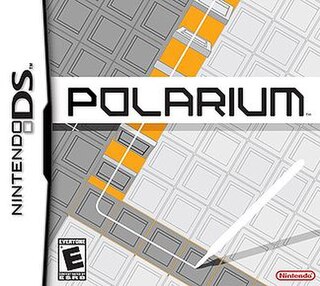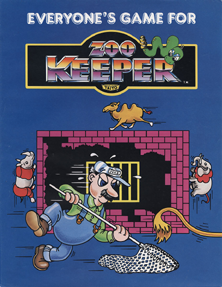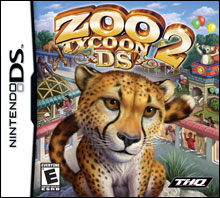
Dr. Mario is a 1990 puzzle video game developed and published by Nintendo for the Nintendo Entertainment System, Famicom, and Game Boy. It was produced by Gunpei Yokoi and designed by Takahiro Harada. The soundtrack was composed by Hirokazu Tanaka.

Tetris Attack, also known as Panel de Pon in Japan, is a puzzle video game developed by Intelligent Systems and published by Nintendo for the Super Nintendo Entertainment System. A Game Boy version was released a year later. In the game, the player must arrange matching colored blocks in vertical or horizontal rows to clear them. The blocks steadily rise towards the top of the playfield, with new blocks being added at the bottom. Several gameplay modes are present, including a time attack and multiplayer mode.

Puyo Pop Fever is a 2003 puzzle video game developed by Sonic Team and published by Sega. It is the fifth main installment in the Puyo Puyo puzzle game series and the second Puyo Puyo game to be programmed by Sonic Team after Puyo Pop. This was the start of the what can be considered a reboot of the Puyo Puyo franchise, with this entry's plot revolving around Professor Accord losing her flying cane. Sega, which acquired the series' rights from Compile in 1998, published all the Japanese releases of the game, and also published the arcade and GameCube versions internationally. The game was scarcely released internationally, and certain versions were released by other publishers in those areas. Only the arcade, GameCube, and Nintendo DS versions were released in North America. Europe received all three versions plus the PlayStation 2, Xbox, Game Boy Advance, and PlayStation Portable versions. The Dreamcast version, released exclusively in Japan, was the last Dreamcast game developed by Sonic Team, the last first-party title released on the platform, as well as the final first-party title by Sega. was ported from the arcade version. The Dreamcast version is the only console version to use sprites in place of 3D models.

Polarium is a puzzle game developed by Mitchell Corporation and published by Nintendo for the Nintendo DS. It was a launch title in Japan, Europe and China. In the game, players use a stylus to draw lines on the DS's touch screen, flipping black and white tiles to clear puzzles.
Point Blank, known as Gun Bullet, or Gunvari in Japan, is a series of light gun shooter games developed by Namco for the arcade, PlayStation and Nintendo DS; the trilogy was first released in arcade in 1994 and was later ported onto the PlayStation. Point Blank DS was released in 2006 for the Nintendo DS featuring 40 challenges from the original series.

Kirby's Star Stacker is a 1997 puzzle video game developed by HAL Laboratory and published by Nintendo for the Game Boy.

Zoo Tycoon 2 is a business simulation video game developed by Blue Fang Games and published by Microsoft Game Studios and MacSoft. Originally released for Microsoft Windows, Zoo Tycoon 2 is also available for Windows Mobile, PDA, and Mac OS X, although expansions are not included in the Mac version. A Nintendo DS version, titled Zoo Tycoon 2 DS, was released in 2008.

Zoo Keeper is an arcade video game created by Taito America and released in 1983. The player controls Zeke, a zookeeper, attempting to rescue his girlfriend Zelda from a zoo where the animals have escaped from their cages. The majority of the game takes place on a screen where the player builds a wall to keep animals in the zoo—jumping escaped animals to avoid contact. Two different platform game levels are interspersed every few rounds. Zoo Keeper was sold as a conversion kit for Taito's Qix.
Konductra is a puzzle game for the Nintendo DS published by O~3 Entertainment. The game had an interesting development cycle, with IGN revealing the title on November 23, 2005. At the time independent developer oeFun had started work without having a publisher lined up. oeFun and O~3 came into a publishing agreement in the summer of 2006 after the title was finished.

Hebereke's Popoon is a two player puzzle video game developed and published by Sunsoft. It is based on the Hebereke series. Hebereke means drunk or untrustworthy. Popoon is an onomatopoeia for the sound made by the game pieces when they explode.

Puzzle Quest: Challenge of the Warlords is a puzzle video game designed by Steve Fawkner for Australian game developer Infinite Interactive and published by D3 Publisher in 2007. The game combines role-playing with tile-matching elements. Taking place in a high fantasy setting, the player moves his or her character around the game's world and encounters monsters and other enemies to fight so as to gain experience and acquire treasure as in a typical role-playing game. Combat takes place on a board similar to Bejeweled, and by making matches of colored gems, the combatants can cause damage to their opponents, cast spells, or perform other abilities that affect the flow of the game.

Planet Puzzle League, known as Puzzle League DS in Europe, and as Panel de Pon DS in Japan, is a video game for the Nintendo DS handheld video game console in the Puzzle League Panel de Pon visual matching puzzle game series. In North America, Planet Puzzle League is part of the Touch! Generations brand; in Japan, Panel de Pon DS is marketed in the general Touch! brand. The publisher for the game is Nintendo, and the developer is Nintendo's second-party developer Intelligent Systems, creator of the original Panel de Pon and its cult classic English-language adaptation Tetris Attack. The game was released in Japan on April 26, 2007 in North America on June 4, 2007, and in Europe on June 29, 2007.

Zoo Tycoon is a series of business simulation video games. The worlds focus around building and running successful zoo scenarios. The series was initially developed by Blue Fang Games and published by Microsoft Studios who later in 2001–2008 went on to create two stand-alone video games and seven expansion packs for PC and Macintosh platforms. In 2013, Microsoft Studios released a new Zoo Tycoon game, developed by Frontier Developments for Xbox One and Xbox 360. An enhanced version of the Xbox game, Zoo Tycoon: Ultimate Animal Collection, was released for Windows 10 and the Xbox One on October 31, 2017. Frontier Developments, the developer of the final Zoo Tycoon game, released the spiritual successor to the series, Planet Zoo, in 2019.

Zoo Tycoon 2 DS is a Nintendo DS game based on the PC game Zoo Tycoon 2. It is the sequel to Zoo Tycoon DS.
Puyo Puyo (ぷよぷよ), previously known as Puyo Pop outside Japan, is a series of tile-matching video games created by Compile. Sega has owned the franchise since 1998, with games after 2001 being developed by Sonic Team. Puyo Puyo was created as a spin-off franchise to Madō Monogatari, a series of first-person dungeon crawler role-playing games by Compile from which the Puyo Puyo characters originated. The series has sold over 9 million copies, including the Madō Monogatari games.

A tile-matching video game is a type of puzzle video game where the player manipulates tiles in order to make them disappear according to a matching criterion. In many tile-matching games, that criterion is to place a given number of tiles of the same type so that they adjoin each other. That number is often three, and these games are called match-three games.

Puzzlejuice is a 2012 indie puzzle video game for iOS produced and developed by video game company Sirvo. The game is a combination of Tetris, tile-matching, and Boggle: players rearrange falling tetromino blocks into rows of similar colors, which turn into letters that are cleared from the board by forming words. The fast-paced game also includes challenges and power-ups. The development team consisted of three people; programmer Asher Vollmer initially developed the game alone, before reaching out to artist Greg Wohlwend for advice on the aesthetics. Composer Jimmy Hinson produced the game's music.

The Groove Coaster series is an iOS / Android and arcade rhythm game franchise developed by Matrix Software and published by Taito. The first Groove Coaster was released for iOS on July 28, 2011. This rhythm game follows a roller coaster type track on screen, where players must make the appropriate controller inputs. Like many rhythm games, a life bar is attached to the game play. Players gain or lose points on the bar depending on the input timings.

Disco Zoo is a zoo simulation video game developed by Milkbag Games and published by NimbleBit for iOS and Android. It was published into the App Store on 21 February 2014 for iOS.















